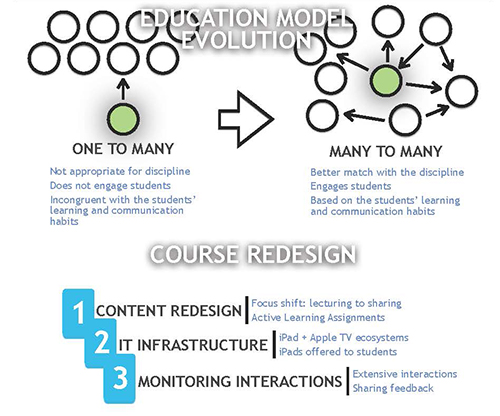As information technology (IT) is increasingly becoming an integral part of today’s societal fabric, its presence in the classroom becomes inevitable. Most of today’s students bring with them at least one mobile device, capable of connecting to the Internet and pursuing a variety of advanced tasks. Whether we accept it or not, IT is definitely changing the way students interact with the instructional material, with their peers and professors. Thus, traditional methodologies, based on a one-to-many philosophy, where the instructor is at the center of the learning process, seem to be incongruent with the reality. Recognizing such challenges, we engaged in a project aimed at synchronizing students’ learning and communication behaviors with methodologies that seem to be more appropriate for disseminating content and engaging students for deeper learning. Our main objective was to facilitate students’ learning of their main instructional content – IT in hospitality – while developing skills such as critical thinking, problem solving, written/oral communication, leadership, and teamwork.
We envisioned a course in which students work in groups to accomplish tasks while sharing the results of their work and their methodologies with their instructor and peers in the real-time. Naturally, the specifics of this particular class dictated some of the parameters of the new course development: first-year experience students with limited knowledge of the managerial processes requiring information technology, high enrollment and amphitheater–style classroom making it difficult for students to collaborate within groups, one-credit hour course limiting the amount of in-class time. This approach required the development of a complete set of assignments, called active learning assignments (ALAs), which were to be completed in groups using iPads and a variety of mobile apps (e.g., Doceri, Skitch, Sketches). We provided the iPads and the Apple TV system, which allowed the groups to share their work with the rest of the class. The students were also required to upload their work on the course’s forum, which allowed the instructor and peers to engage in rich comments and discussions. We did not eliminate traditional components of instruction, but instead created an environment where traditional and contemporary instruction can symbiotically coexist.

Upon a comprehensive assessment process and continuous evaluation by the instructor, we found a number of very interesting outcomes. Addressing the primary goal, we found that the students were better at mastering the material, and could be engaged in higher learning processes. Not surprisingly, we found that the students greatly enhanced their level of engagement, their communication, problem solving, and leadership skills. Unexpectedly, we found that the students were also stimulated to showcase their creativity, which, combined with all the other skills produced outstanding outcomes. We are still making adjustments in order to best capture the dynamics of the sections being taught, the technology advancements, and the types of core skills that are required from this course. However, this project opened our eyes to today’s instructional realities, where technology can be channeled to enhance student higher education learning.




